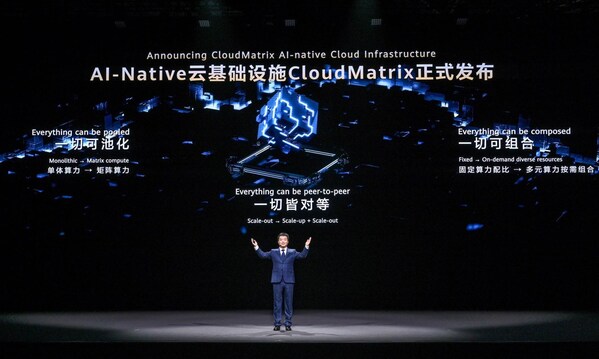SHANGHAI, Sept. 20, 2024 /PRNewswire/ -- At HUAWEI CONNECT 2024, Executive Director of the Board of Huawei and CEO of Huawei Cloud Zhang Ping'an delivered a keynote speech "Thrive with the Cloud: Reshaping Industries with AI". Zhang states that enterprises must seize opportunities in the intelligent era and use AI to build competitive advantages. The key is to adopt an AI-native mindset now.
First, enterprises should actively embrace AI, open up industry scenarios, and develop enterprise AI platforms. This will enable AI to serve their core business. Today, Huawei Cloud Pangu Models have been applied in more than 30 industries and 400 scenarios.
Second, AI computing power is critical. Enterprises need to build AI-native cloud infrastructure that matches their requirements. Zhang officially released CloudMatrix to interconnect and pool all resources including CPUs, NPUs, DPUs and memory. It marks an evolution from monolithic to matrix compute. CloudMatrix comprises an AI-native cloud infrastructure in which everything can be pooled, peer-to-peer, and composed, providing enterprises with abundant AI computing power.
Third, data quality determines the effectiveness of AI models. We need to build knowledge-centric data foundations to enable data to serve AI better. Huawei Cloud has fully upgraded DataArts to provide customers with AI-oriented and knowledge-centric data foundations. The updated features include AI+data convergence engines, data development and governance, knowledge services, and AI+data application enablement services.
Fourth, build suitable AI models based on business applications. We must abandon the misconception that larger models are better. It is not feasible to address all needs with just one foundation model. Pangu Models 5.0 are available in different sizes, with parameters in the billions, tens of billions, hundreds of billions, and trillions. The complete series of Pangu models meet practically all business application needs.
In addition, Huawei Cloud's Pangu 5.0 models enhance spatiotemporal controllable generation (STCG) in the field of multimodal generation. For autonomous driving,the Pangu model can generate driving scenarios that accurately mirror the physical world. It can generate videos that reflect normal driving scenarios, random road conditions and accidental and aggressive driving, allowing automotive enterprises to train autonomous driving more efficiently.
Huawei Cloud officially released the Mainframe-to-Cloud Solution, designed to help customers develop new core systems on the cloud with high availability, easy O&M, and better agility, helping customers achieve 99.999% financial-grade high availability. Currently, most banks in China have chosen Huawei to build their new core systems on the cloud.
Tao Jingwen, Huawei's Director of the Board and President of the Quality, Business Process & IT Mgmt Dept, recounted Huawei's digital transformation journey. Huawei has developed a methodology, which can be broken down into three layers, five phases, and eight steps. The three layers are redefining intelligent business, AI model development and delivery, and ongoing optimization of intelligent applications. The five phases are identifying suitable scenarios, reshaping processes, transforming organizations, optimizing corporate data, and adopting AI applications.
Bruno Zhang, CTO of Huawei Cloud, presented insights on how Huawei Cloud is leveraging AI to reshape data centers, infrastructure, and cloud services. He also addressed the construction of an AI-native cloud designed to accelerate intelligence in industries. The "1+N" Pangu assistant system, unveiled by Mr. Zhang, signifies a new era in cloud service interaction. The system includes Pangu Doer, and the myriad use cases in product R&D, data analytics, security, and office collaboration, where Pangu models are trained using the scenario-specific data, know-how, and practices to enhance cloud services and boost efficiency with tailored AI.
source: HUAWEI CLOUD
【你點睇】港鐵失倫敦伊利沙伯線專營權,你認為「國際化」遇挫的港鐵應否將重心轉移回本地?► 立即投票

































